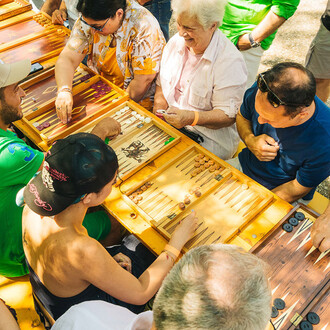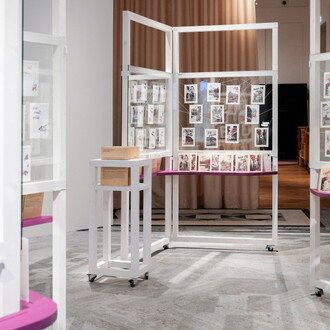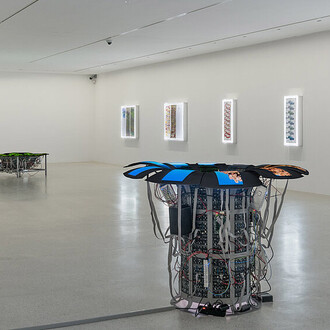In his new solo exhibition at Beck & Eggeling, Greek artist Apostolos Palavrakis (b. 1962) presents a selection of works that spans from his newest productions back to works from the late 1990s. Over these almost 20 years, Palavrakis’ style has developed decisively, with the sensual, lyrical approach he pursued in the 1990s evolving into a clear, almost austere formal objectivity that privileges structure and form over expressive gesture and mythical aura. Nonetheless, Palavrakis is still able to lend his works a dark secret that never entirely discloses itself to the viewer.
In the exhibition, the artist shows works from his early and later periods within a common conceptual framework. Even though he has consciously chosen to confront the past with the present here, this presentation doesn’t trace his artistic development so much as it consolidates his individual works into a new entity, which emerges from the interplay of the works.
At the centre of the exhibition are sculptures and objects from the past six years. The works Ur-Haus II / extension and collapse and Aggregat I / Element XIII - XVI evoke architectural models. Indeed, Palavrakis was trained as an architect, and he assembled these objects from fragments of existing architectures. The cool elegance and grandeur of the forms initially conceal the impossibility of their construction which defies the laws of nature. The mirrored gas bottle of Module 94 and the mysterious apparatus in Module 14 defy our understanding by leaving us uncertain as to their respective functions. The gas bottle in a glass case arouses our desire, but it never reveals why it must be protected or whether it brings misfortune or a blessing once opened. Likewise, the equipment of Module 14 betrays just as little about the nature of the system that it seems to support. The Fifth Element after Kazimir Malevich invokes a key moment in modern art, but the viewer is left to consummate it in their imagination. The magic square of light that the fluorescent tubes could produce remains segmented. What power would flow from it if it were whole? The series of drawings from 1997 functions as a chaotic counterpoint to the technical perfection of the objects. Rows of characters, letters, and numbers on torn-out sketchbook pages seem like a cryptograph that uses known characters without revealing its contents. Thick layers of graphite cover them, sometimes partially, sometimes almost filling the pages. Any lingering possibility of deciphering the secret is forever lost under the impenetrable blacks.
As hermetic as some of Palavrakis’ works may seem, they still evoke wide-ranging associations from the history of art, architecture, the humanities, science, and technology. Together, they combine a mythical past, where there seems to be only progress, with our technocratic present, where we have only recently realized that each human achievement also carries the potential of destruction and chaos within it. But what remains?
Palavrakis has captioned the exhibition’s title, Desire and Disaster, with a line from a Rilke poem. “For beauty is nothing but the beginning of terror, which we still are just able to endure, and we are so awed because it serenely disdains to annihilate us." writes the poet at the beginning of the first of his Duino Elegies. Beauty thus exists only in the face of terror. The tableau that Palavrakis has conceived in Desire and Disaster condenses the futility expressed in this line into a singular moment which levels the incompatibility of utopia and dystopia, of becoming and collapse. The moment which we still are just able to endure when beauty reveals itself to us. (Sebastian Schemann, 2018)
Apostolos Palavrakis was born in 1962 in Trikala, Greece and has lived in Germany since the 1980s. The artist and the gallery are connected through a longstanding collaboration that dates back to the gallery’s beginnings in 1994 in Leipzig. Desire and Disaster is the artist’s fifth solo exhibition at the gallery.
Apostolos Palavrakis lives and works in Dortmund and Thessaloniki.















